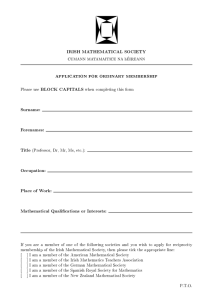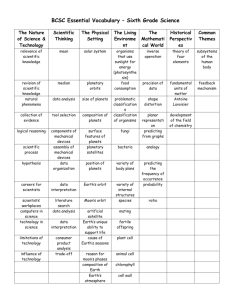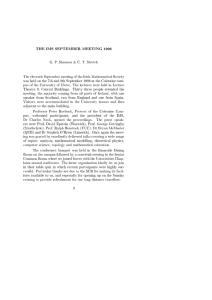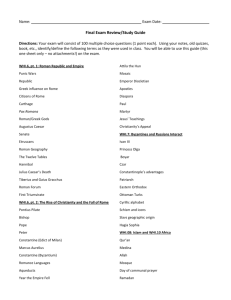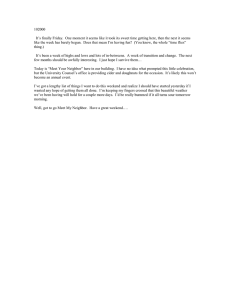Document 11012134
advertisement
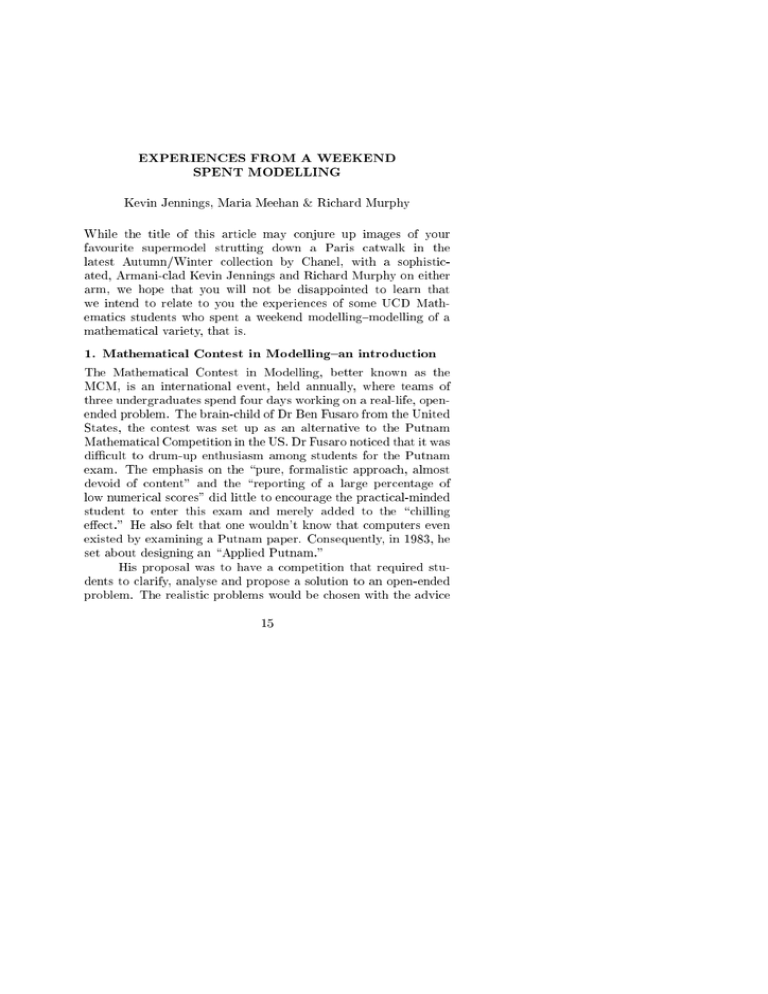
EXPERIENCES FROM A WEEKEND
SPENT MODELLING
Kevin Jennings, Maria Meehan & Rihard Murphy
While the title of this artile may onjure up images of your
favourite supermodel strutting down a Paris atwalk in the
latest Autumn/Winter olletion by Chanel, with a sophistiated, Armani-lad Kevin Jennings and Rihard Murphy on either
arm, we hope that you will not be disappointed to learn that
we intend to relate to you the experienes of some UCD Mathematis students who spent a weekend modelling{modelling of a
mathematial variety, that is.
1. Mathematial Contest in Modelling{an introdution
The Mathematial Contest in Modelling, better known as the
MCM, is an international event, held annually, where teams of
three undergraduates spend four days working on a real-life, openended problem. The brain-hild of Dr Ben Fusaro from the United
States, the ontest was set up as an alternative to the Putnam
Mathematial Competition in the US. Dr Fusaro notied that it was
diÆult to drum-up enthusiasm among students for the Putnam
exam. The emphasis on the \pure, formalisti approah, almost
devoid of ontent" and the \reporting of a large perentage of
low numerial sores" did little to enourage the pratial-minded
student to enter this exam and merely added to the \hilling
eet." He also felt that one wouldn't know that omputers even
existed by examining a Putnam paper. Consequently, in 1983, he
set about designing an \Applied Putnam."
His proposal was to have a ompetition that required students to larify, analyse and propose a solution to an open-ended
problem. The realisti problems would be hosen with the advie
15
16
IMS Bulletin 41, 1998
of mathematiians who worked in industry and government. Students would be able to draw on outside resoures inluding omputers, texts or any other inanimate soure. The entire modelling
proess would be emphasized, and therefore substantial weight
would also be given to how the solution was written up. In disussions with members of SIAM, the Soiety of Industrial and Applied
Mathematis, one expert noted that to make the senario realisti,
students would need to be given a whole semester to work on
the problem. However it was eventually deided that the ontest
should take plae over four days. Finally a numerial sore would
not be awarded. Rather, suessful teams would be ategorized
in asending merit as Suessful Partiipants, Honorary Mention,
Meritorious and to the best six teams, the title of Outstanding
Meritorious would be awarded and their papers published in a
professional Mathematis Journal.
The rst MCM was held in 1985, and the ommittee was
delighted to disover that it was a resounding suess, with 90
papers, representing 70 olleges, submitted. Sine then, the MCM
has grown from strength to strength. The 1998 MCM saw 472
teams partiipate, representing 246 institutions from 8 ountries{
Australia (2 teams), Canada (11), Finland (1), Hong Kong (2),
Ireland (10), Lithuania (1), P.R. China (138) and the United States
(307). The ontest is not limited to third level institutions, and
this year 13 high shools also partiipated.
2. The MCM in Ireland
The MCM arrived in Ireland along with Professor Pat Lambert
from the University of Fairbanks, Alaska in 1991. While visiting University College Galway and Trinity College Dublin, in the
1990/1991 aademi year, Professor Lambert enouraged sta and
students in both universities to give the ontest a go. As a student
of Mathematis in UCG at the time, I attended a talk given by
him, where he explained how the ontest worked, desribed what
a unique learning experiene it was, and most importantly, what
an enjoyable weekend ould be had by all involved. Dr Ray Ryan
and Dr Pat O'Leary in UCG put all their support behind the idea
and thus 1991 saw the rst Irish entries in the ontest, from both
Experienes from a weekend spent Modelling
17
UCG and Trinity.
Ireland has been suessfully represented by teams from
various universities sine then. UCD joined the partiipants for the
rst time this year after I managed to ajole/trik/blakmail/beg
various students to oer up a weekend of their lives in the name of
Mathematis. The preparations ommened in late Otober when
I gave an introdutory talk on the ontest to a mixed group of students. Sine UCD had not previously partiipated in the MCM,
the students had only my word on what the ontest entailed and
it proved more diÆult than I thought to onvine them that their
partiipation in this weekend would be a worthy investment in
many ways. However, a group of about ten gullible students were
suÆiently fooled and the training began.
We met usually twie a week, and with the help of Dr Ted
Cox and Dr Peter Duy, the andidates were introdued to some
previous MCM problems and sample solutions. Sine one an't
over in an hour, what is supposed to take four days, the most
one an do is give an idea of how one might approah a partiular problem. The Brain-Drug problem, Emergeny PowerRestoration problem, Salt-Storage problem, Steiner-Tree problem
and Veloiraptor problem were just some that were disussed.
The next main task was to hoose the teams. Many veteran
team advisers have written on the ideal ombination of students
for a team. One suggestion is that with suh a large emphasis
plaed on the exposition of the solution that the ideal team should
onsist of three English majors, one of whom is minoring in mathematis, although I would be extremely unwilling to try out that
partiular ombination! Another oah suggests that eah team
requires one person who has a \terrier personality : someone who
is jumpy, oming up with a new approah every thirty seonds or
so," although he wisely points out that you an't put two people
of that temperament together in a room for four days. Therefore
the suggestion is that there has to be a team member \who an
lend a degree of stability to the team{someone who an keep the
terrier reined in, with a leash if neessary." Students of this type
are easily reognized as \the ones who are in lass every day with
their homework done and know what they are going to be having
18
IMS Bulletin 41, 1998
for dinner two weeks from next Tuesday." The nal team member
should be a ombination of both personalities. What is absolutely
ertain however is that one team member has to be able to program
well.
One of our teams onsisted of a fourth year MathematisMathematial Physis student, a fourth year Eletroni Engineering student and a rst year Siene student, while another team
was omprised of a student from fourth year Mathematis, one
from seond year Siene and one from rst Mediine. Another
team onsisting entirely of rst years deided to give the weekend
a go, however due to the lak of a programmer on the team, they
retired from the ontest after a brave attempt.
With Friday 6 February quikly approahing, sponsorship
was sought and found in the form of money, 4 large pizzas, 196
bottles of oke and 100 doughnuts. Four willing sta members
handed over the keys to their respetive oÆes along with their
prized omputers. Seurity was alerted to the fat that some students would be spending the weekend ensoned in the department
and the head of seurity kindly set up an emergeny \hot-line" to
the oÆes should anything go wrong. One junk-food shopping
spree later (although I did buy fruit but it wasn't eaten!) to stok
up the Mathematis Department lass room whih doubled up as
anteen for the weekend, and we were ready to roll.
The two MCM problems, from whih eah team had to
hoose one to work on, arrived on my desk a week prior to the
ontest, with the words DO NOT OPEN UNTIL 12.01AM,
FRIDAY 6, FEBRUARY emblazoned menaingly aross them.
Despite my protests that a good night's sleep would be more beneial to our partiipants, they opted to meet at a loal watering hole on Thursday night, and at a minute past midnight, the
ontents of the envelopes beame publi knowledge (muh to the
astonishment of the other ustomers sitting in the hotel's foyer).
One problem was entitled \Grade Ination" while the other was
on \MRI Sanners." Both of our teams eventually hose the latter problem. The problem explained that Magneti Resonane
Imagers (MRI) san a three dimensional objet suh as a brain
and deliver their results in the form of a three dimensional array
Experienes from a weekend spent Modelling
19
of pixels. These sanners usually inlude failities to piture on
a sreen any horizontal or vertial slie through the three dimensional array. The problem lies in nding an algorithm for pituring slies through oblique planes. It is pointed out that \urrent
algorithms are limited in terms of the angles and parameter options
available; are implemented only on heavily used dediated workstations; lak input apabilities for marking points in the piture
before sliing; and tend to blur and `feather out' sharp boundaries
between the original pixels."
In what follows, Kevin Jennings, a member of one of the
teams, desribes his experiene of the rst two days of the ontest, while Rihard Murphy, who was on the other team, gives
an aount of the two nal days. Both Kevin and Rihard are
urrently doing postgraduate work in Mathematis at UCD.
3. Friday, 6 February, 1998
\That's the lamest exuse I've ever heard from somebody not
{my parents sowled as I left home that morning.
working in CIE"
I had just given them the less than redible explanation that I'd be
spending the weekend in an oÆe in the Mathematis Department
in UCD with two other lads, working on a maths problem.
Stephen and Conor were already researhing neuro-medial
sanners when I arrived. We felt we had managed to foil the other
team's early eorts, by souring the library for the most relevant material and piling it on our desk. However they had exatly
the same idea, and the ensuing battle taught us our rst lesson:
despite the advanes in neuro-medial siene, the human being is
still quite a primitive beast. Maria brought us for lunh, where
we remembered that we were in fat sophistiated students, and
the daggers that we threw at the other team beame sharpened
with words of Latin origin. Subtle psyhologial tehniques were
applied to enable us to wean useful information out of our opponents. Of ourse we blued when they tried the same.
After lunh we gave the seond problem on \Grade Ination" some thought, and disussed the merits of a proposition that
UCD should only award rst lass honours degrees, no matter how
unworthy the sripts. This problem didn't ath the imagination
20
IMS Bulletin 41, 1998
quite as muh as the thought of looking at the inside of a head. The
fat also that we were already enthusiasti about the rst problem
and had a few ideas taking shape, meant that we promptly dismissed the seond problem. In retrospet, we may have been too
hasty in this deision, but time was passing, the adrenaline was
owing and a deision had to be made. Lesson number two{how
to make a deision under time onstraints.
Now that we had deided on the MRI Sanners problem,
we set about organizing a strategy that would enable us to work
independently on dierent aspets of the problem, while still omplementing eah other. Conor, our omputer expert, set about
retrieving information from the Internet and designing a omputer
program that would display the desired information. Stephen and
I brainstormed for dierent mathematial models and read more
about how the sanners atually worked.
A ruial part of the proedure was trying to deide what
type of model to use. The standard approah seemed to be to
treat it as an interpolation problem, and use various tehniques of
interpolation to minimize the inevitable disrepanies that would
arise in going from a disrete to a ontinuous system. We eventually adopted an approah where we assumed that the data points
represented spatial ubes, and thus lled spae. Having adopted
this approah, it was onvenient to ignore the short-omings of
this model and work on exploiting its advantages. Again, in retrospet, knowing the limits of our model would have oered greater
insights as to its potential. This an important gem of knowledge
whih I olleted from the experiene {know your limits! Thus
lesson number three was learned.
We didn't work too late on Friday night as Maria had suggested that we onserve our energy for the long weekend ahead,
whih she assured us would be franti. My mother was pleased to
see me when I arrived home, and just to onvine her of my sanity,
I told her that I wouldn't be home on Saturday or Sunday night
as I'd been invited to a massive \Boogie Nights" party hosted by
Guinness and TV3 newsreaders. She seemed muh happier with
this explanation and handed me a tenner. I spent a few hours
reading about sanners that night, and next morning, Saturday,
Experienes from a weekend spent Modelling
21
we started the hard work in earnest.
4. Saturday, 7 February, 1998
It quikly dawned on myself, Stephen and Conor that there was
no ingenious solution to this problem strewn aross Professor Laffey's desk, and those \trivial" alulations, that we had so glibly
spoken about the previous day, would have to be detrivialized.
We got down to the hard slog of trying to wrap our brains around
three dimensional rotations and express our onlusions. [Note
from Maria: I think I walked in on Kevin during this stage of the
proeedings. He was lying at on his bak on the ground with an
extremely fraught look on his fae, and rotating a piee of ardboard over his head.℄ Conor then interpreted them on the omputer and, of ourse, as there were \small" aws in our method,
we therefore set about looking for errant minus signs and varying onstants. Finding these partiular aws beame something
of a personal hallenge, and all sight of the problem was lost as
I went about trying to repair a hose of unknown length, with an
unknown number of holes, using only a nite number of biylepunture repair kits (metaphorially speaking of ourse). The idea
of the ontest was that we ould draw from established material,
but it was so muh more exiting to try and ome up with the
tools ourselves. Lesson number four: perhaps we didn't exploit
this option to the full.
The other team was enountering similar frustrations, and
when Maria arrived with enough junk-food to feed Elvis for a
month, we ongregated and seretly took pleasure in their ontorted faial features and their freshly-formed little bald-pathes
where hair had been foribly removed. The entire seletion
of risps, doughnuts, hoolate, oee, runhy-nut ornakes,
morphine et. was kept in a ommon room, and it was not
unusual to nd somebody banging his head o the blakboard
when you entered looking for a oee.
Condene was high all round and we were all on the verge
of announing a proof of the Riemann hypothesis as a orollary
to our work. It was at this point that Maria asually reminded
us that ideally we should be starting the write-up by midday on
22
IMS Bulletin 41, 1998
Sunday. The eet of these words on our brain-ells was akin
to the eet throwing a stone at the queen would have on a beehive. Suddenly addition of 3 3 matries required a formula and
nding inverses beame trivial. Soon every aspet of mathematis
beame trivial, exept those aspets whih we required for our
model. If only we'd hosen a dierent model, the solution would
have been obvious! We worked frantially until a late hour, and
after sweating all the aeine out of our systems, [Note from Dr
Marjoram, who donated his oÆe to this team: it took a full week,
with all the windows open, to rid my oÆe of the woeful smell!℄
we got some sleep before the nal battle.
5. Sunday, 8 and Monday, 9 February, 1998
And thus we have reahed the point where I take over from my
esteemed olleague Mr Jennings and begin relating my experienes
of the seond half of the weekend. Sunday morning is the point at
whih I will start; an opening made onvenient by our unanimous
deision to return to our respetive homes and have deent rests
for the night. Unanimous, exept of ourse for the indomitable Mr
Jennings, who just had to bring in a sleeping bag, and by staying
in ollege, snath a few preious hours of sleep and get one over on
everyone else. Not that we all had gone to bed early on Saturday
night. I think it was sometime after four on Sunday morning when
I got to the safety of my osy bed, whih meant that it was atually
bordering on the afternoon when I arrived in.
Our team had also opted for the MRI problem. I had somehow ontrived to spend almost two days trying to derive equations to transform three-dimensional oordinates into the twodimensional position on the slie, taking an inordinately long time
to gure out the various ways a plane an interset a uboid. Having nally ahieved this, my next task was to surmount the problem posed by disreteness: when you interset a pixel lattie with a
plane, you don't get the nie neat olletion of uniform squares one
needs for omputer display purposes (unless you're very luky or
just plain unadventurous). For the time being we were going to use
rude rounding-o tehniques, but something better was required.
I set about my task with the same trademark vigour and eÆieny
Experienes from a weekend spent Modelling
23
I had exhibited already. Meanwhile, David was busying himself
with nding sample material with whih we ould test our nished
program. To this end he trawled the Internet in searh of layered
ross-setions of brains from whih we ould onstrut our lattie.
The atual program was being taken are of by Robert (our omputer expert), who was glad at last to have some equational fodder
to stik into the program, that he might eventually have some sort
of working thing in plae. Inevitably, I have been able to divulge
more of my endeavours than those of my teammates, being as I
am more familiar with them.
We ertainly nished the ontest a good deal fatter that
when we began { I don't think I ever drank so muh oke or ate
so many doughnuts in suh a short spae of time. We got fed
twie on Sunday to prepare us for the night of madness ahead.
Unfortunately, not being renowned for a voluminous appetite, I
ould gorge myself little more by the time the Chinese take-away
arrived. Still, too muh food is a good omplaint to have, and
it was ertainly better than my usual diet of bread and burnt
ornakes.
Being suh aring folk, we were at great pains to regularly
visit the others and see how they were doing. Indeed at times suh
was our altruisti enthusiasm that we would burst into their room
unannouned, and aidentally see some of their work. On other
oasions, we were more restrained and hovered undeidedly at the
door wondering whether or not to go in, sometimes for minutes at
a time. This too ould lead to unfortunate overhearing. Not that
we had a monopoly on onern, mind. The other team were just
as, nay more, eager to see if we were doing okay.
Surprisingly, given my preeding suesses, I failed to ome
up with any improvement on our rough rounding{o sheme over
the ourse of the day. David's Internet-raiding sheme had also
run aground on importation diÆulties, but he deided to reate a rough Eulidean approximation of the brain with whih we
ould test our program. Robert was enountering teething diÆulties with said program, not the least of whih was the limitation
imposed by memory, whih meant that our lattie had to be onsiderably smaller than it was meant to be. He hoped to use the
24
IMS Bulletin 41, 1998
hard disk as an extension of memory.
As day beame night, our tired and errati minds found
it inreasingly diÆult to grapple with the problems we were to
overome. After a while it beame lear that we needed to emulate Poinare in his work on Fuhsian Funtions. Thus we played
football for about half an hour, hoping the respite would bring
fresh insight as in the ase of the great man. Or maybe we just
played football. Either way, we felt it beneial, for we repeated
the proess throughout the night.
Around three or four on Monday morning, both teams began
the writing-up proess. This was the ultimate penane. Figuring
out an approah to a problem and attempting to esh out your
ideas is an endeavour rih in dead ends, exiting insights and general ativity. But having to elaborate extensively on a projet with
whih you are intimately familiar, to the point of it all seeming
quite obvious, is at four in the morning a labour of the damned.
I was also quite distressed to disover, by the oasional ursory
glane at our rivals' thesis, that ours was not quite so profuse in
's, 's or even 's, as theirs. However, I did manage to appease
my pretentiousness by inluding a theorem (in the broadest possible sense) in an appendix, but it's just not the same.
In addition, the deit of sleep over the previous few days,
and omplete lak of it on this night, was starting to take its toll.
Exhaustion was beoming overtiredness and then delirium, whih
was of ourse for the more Dionysian among us its own reward.
While it imbued the writing-up proess with more than its fair
share of hilarity, it made the ompilation of any sort of oherent
resume of our eorts an uphill struggle, to say the least.
By the end we had atually got a working program, at least
in the sense that it hose to work for any weird angle you ared to
throw at it, but perversely rewarded you with omplete garbage
if you gave it a nie slie aligned with the axes. Towards the
end we had the usual problem of everyone trying to get as muh
done before the 5pm deadline, whih meant that the write-up was
being onstantly hopped and hanged amid fears that an inorret
version might be submitted. Still, somehow, we managed to get
everything in plae, in time. It was quite a relief to have the thing
Experienes from a weekend spent Modelling
25
nally nished, to put it out of our minds and relax. And then
the Poinarean insights ame.
With the ordeal over, the person responsible for bringing the
event to our ollege, the elegant, resoureful, talented, dynami
and ever-delightful Dr Meehan (Note from Maria: You never
reovered from the delirium then Rihard?) treated us to a ouple
of pints in the UCD bar. Exept of ourse for the ever-eentri
Jennings who disappeared to wash or something. Never having the
highest resistane to alohol, I found my friend delirium making
a welome return, and I wound up omplaining that people don't
look at the world from the point of view of ows quite enough.
What's wrong with the world these days? Having ruthlessly put
paid to any form of deent soial onversation with my proselytizing, our party soon broke up and we went our separate ways.
By the time I got home, delirium had fallen from favour and was
replaed in my aetions by bed, whih was never so dear. An
exhausting but rewarding weekend all round.
Referenes
[1℄
MCM{the rst ten years,
The UMAP Journal, 1995 COMAP, In.
Kevin Jennings, Maria Meehan & Rihard Murphy
Department of Mathematis
University College Dublin
Beleld
Dublin 4
